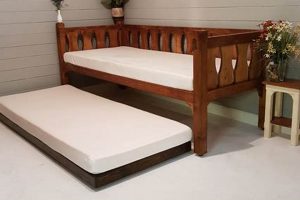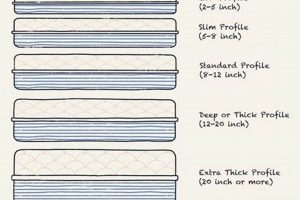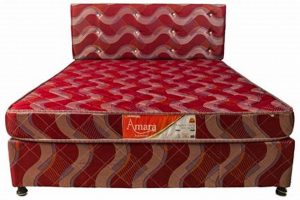These sleeping systems consist of a large-sized (approximately 76 inches wide by 80 inches long) bed frame capable of articulation and a conforming sleep surface designed for use on such a frame. These units offer a greater sleeping area than smaller alternatives, coupled with the ability to adjust the angle of the head and/or foot sections of the bed.
The utility of such systems lies in their capacity to provide personalized comfort and support. Elevating the head can alleviate symptoms of acid reflux and sleep apnea. Raising the legs may improve circulation. Historically, similar mechanisms were employed in hospital settings to assist patients with mobility challenges or specific medical needs. The increased comfort afforded can also enhance sleep quality.
Subsequent discussion will address the selection criteria for these systems, including motor types, mattress materials, available features such as massage and integrated technology, and considerations for suitability based on individual needs and preferences.
Selection Guidance
Careful evaluation is essential when acquiring such a sleep system to ensure optimal comfort and long-term satisfaction.
Tip 1: Motor Evaluation: Assess the motor’s noise level and lifting capacity. Quieter motors promote undisturbed sleep, while adequate lifting capacity ensures the bed smoothly adjusts under combined user weight.
Tip 2: Mattress Material Selection: Consider materials like memory foam, latex, or hybrid constructions. Memory foam contours to the body, latex offers resilience, and hybrid options balance support and comfort. Personal preferences and sleep style should guide the choice.
Tip 3: Frame Construction Quality: Inspect the frame’s material and joint construction. Steel frames offer superior durability. Reinforced joints contribute to overall stability and prevent premature wear.
Tip 4: Feature Assessment: Evaluate additional features like massage, USB ports, and under-bed lighting. Determine if these features align with individual needs and provide tangible benefits.
Tip 5: Remote Functionality: Examine the remote’s ease of use and available functions. A user-friendly remote with clearly labeled buttons enhances the adjustment experience.
Tip 6: Warranty Review: Scrutinize the warranty terms, including coverage duration and limitations. A comprehensive warranty provides protection against defects and malfunctions.
Tip 7: Trial Period Exploration: If possible, take advantage of trial periods offered by retailers. This allows for in-home testing to assess comfort and suitability before committing to a purchase.
Adhering to these guidelines can significantly improve the likelihood of selecting a system that delivers lasting comfort, support, and functionality.
The following sections will further discuss specific features and their impact on user experience, as well as address maintenance recommendations.
1. Size and Space
The dimensions of a king-size adjustable bed system, approximately 76 inches in width and 80 inches in length, necessitate careful consideration of available bedroom space. Insufficient room to accommodate such a bed may impede its functionality and diminish the user’s overall comfort. For example, placing a king-size adjustable bed in a small room can restrict movement around the bed, hindering access to other furniture and creating a sense of confinement. The adjustable nature of the bed further compounds the space requirement, as the head and foot sections extend beyond the static dimensions when raised.
Beyond the bed’s footprint, allowance must be made for adequate clearance to enable the bed’s articulation. The mechanisms responsible for raising and lowering the bed sections require unobstructed space to function correctly. Inadequate space can result in the bed colliding with walls or other objects, potentially damaging both the bed and the surrounding environment. Furthermore, the accessibility of controls and the ability to comfortably enter and exit the bed are directly influenced by the available space. A bedroom with limited square footage may necessitate the selection of a smaller bed size to ensure optimal usability and safety.
In summary, the successful integration of a king-size adjustable bed hinges on the adequacy of the room’s dimensions. Careful measurement and spatial planning are crucial to avoid compromising functionality, safety, and overall comfort. Overlooking this aspect can lead to practical challenges and negate the benefits of an adjustable sleep system. Therefore, assessing the relationship between bed dimensions and available space is a fundamental prerequisite to procurement.
2. Adjustability Features
The articulation capabilities are a core differentiator of these beds. The ability to independently adjust the head and foot sections allows for customized sleeping positions. Elevating the upper body, for example, may reduce snoring and alleviate symptoms of acid reflux. Raising the lower extremities can improve circulation and reduce swelling. These adjustments are typically achieved through motorized mechanisms integrated into the bed frame.
The effectiveness of these features is directly related to the quality of the motor system and the range of adjustability offered. A robust motor provides smooth and reliable adjustments, while a wider range of positions allows for greater customization. Some models include pre-set positions for common activities such as reading or watching television. Advanced features may include programmable positions and integrated massage functions. The mattress must also be compatible with the adjustable base, offering sufficient flexibility to conform to the bed’s changing contours without compromising support.
The availability and functionality of adjustability features directly impact the user experience and the potential health benefits derived from these systems. Careful consideration of the available features and their suitability to individual needs is essential when selecting a king-size adjustable bed with a mattress. Neglecting this aspect can lead to dissatisfaction and a failure to realize the intended benefits of the product.
3. Mattress Material
The selection of mattress material is a critical determinant of both comfort and performance when paired with a king-size adjustable bed. The material’s inherent properties directly influence its ability to conform to the adjustable base and provide adequate support across various angles and positions.
- Memory Foam Adaptability
Memory foam mattresses are valued for their contouring capabilities. Their viscoelastic nature allows them to compress and adapt to the shape of the adjustable base, minimizing pressure points. However, some high-density memory foams may exhibit limited breathability, potentially leading to heat retention. The density and composition of the memory foam should be carefully considered to balance comfort and thermal regulation.
- Latex Flexibility and Responsiveness
Latex mattresses, particularly those made from natural or blended latex, offer a resilient and flexible surface suitable for adjustable beds. Latex responds quickly to changes in position, providing consistent support. Additionally, latex is naturally breathable and hypoallergenic, making it a suitable option for individuals with sensitivities. The firmness level of the latex mattress should be chosen to align with individual support preferences.
- Hybrid Construction Considerations
Hybrid mattresses combine elements of innerspring coils with layers of foam or latex. This construction aims to provide both support and comfort. When used with an adjustable base, the coil system must be designed to articulate without compromising the mattress’s structural integrity. The layering of foam or latex over the coils should offer sufficient flexibility to conform to the adjustable positions. The coil gauge and arrangement influence the mattress’s ability to adapt to the adjustable base.
- Innerspring Limitations
Traditional innerspring mattresses may exhibit limitations when used with adjustable beds. The rigid nature of the coil system can restrict the mattress’s ability to conform to the adjustable base, potentially leading to discomfort and uneven support. Furthermore, the stress placed on the coil system during articulation can reduce the mattress’s lifespan. Innerspring mattresses with individually wrapped coils offer improved contouring compared to those with interconnected coils; however, they may still not provide the same level of adaptability as foam or latex options.
The selection of mattress material significantly influences the overall performance and longevity of a king-size adjustable bed system. Careful evaluation of material properties, including flexibility, support, and thermal regulation, is essential to ensure optimal comfort and satisfaction. The chosen material should be compatible with the adjustable base’s articulation capabilities to provide consistent support across various positions.
4. Motor Quality
The operational effectiveness and longevity of a king-size adjustable bed are intrinsically linked to the quality of its integrated motor system. The motor serves as the primary actuator, responsible for smoothly and reliably adjusting the bed’s position in response to user commands. An inferior motor can manifest as sluggish or jerky movements, excessive noise, or complete failure. Such issues compromise the user’s ability to achieve desired comfort positions and may necessitate costly repairs or replacements. For example, a motor with insufficient torque may struggle to lift the combined weight of the mattress and occupants, resulting in incomplete articulation and diminished functionality. Conversely, a high-quality motor delivers quiet, precise, and dependable performance, enhancing the overall user experience and extending the bed’s lifespan.
The design of the motor also impacts safety and reliability. Overheating protection mechanisms, overload sensors, and durable construction materials are essential features of a high-quality motor. The absence of these safeguards can lead to motor burnout, creating a potential fire hazard and rendering the bed unusable. Furthermore, the motor’s power consumption should be considered, as inefficient motors can contribute to increased energy costs. Examples of reputable motor manufacturers often cited in the adjustable bed industry include those adhering to stringent quality control standards and providing comprehensive warranties. The choice of motor type, such as linear actuators or worm drive systems, also influences performance characteristics, with each offering distinct advantages in terms of speed, power, and noise reduction. Proper installation and regular maintenance of the motor are crucial for ensuring its continued functionality and preventing premature failure.
In summary, the motor’s quality represents a critical determinant of a king-size adjustable bed’s performance, safety, and durability. Compromising on motor quality to reduce initial costs often leads to long-term expenses and diminished user satisfaction. Therefore, prospective buyers should prioritize models equipped with robust, reliable, and well-engineered motor systems from reputable manufacturers. While challenges exist in objectively assessing motor quality prior to purchase, examining specifications, warranties, and customer reviews can provide valuable insights. A well-chosen motor ensures the adjustable bed delivers consistent, safe, and comfortable performance for years to come.
5. Frame Durability
Frame durability directly influences the lifespan and operational integrity of these large adjustable sleep systems. A robust frame provides the necessary structural support to withstand the dynamic stresses imposed by articulation and the combined weight of the mattress and occupants. Inadequate frame construction can lead to premature wear, bending, or even breakage, rendering the adjustability feature useless and potentially creating safety hazards. For instance, a frame constructed from thin-gauge steel may buckle under repeated use, causing the bed to sag or malfunction. A durable frame, typically built from heavy-gauge steel or reinforced wood, maintains its structural integrity over time, ensuring reliable support and consistent performance of the adjustability mechanisms.
The construction methods employed in frame assembly also significantly impact durability. Welded joints, for example, offer superior strength and stability compared to bolted connections, which can loosen over time. Reinforced corners and cross-braces enhance the frame’s resistance to bending and twisting. The type of motor mounting system used is similarly important, as it must securely attach the motor to the frame without causing undue stress or vibration. Frame coatings, such as powder coating or rust-resistant paint, protect against corrosion and extend the frame’s lifespan. A well-constructed frame not only supports the adjustability mechanisms but also provides a stable platform for the mattress, preventing it from shifting or deforming during use. This is particularly crucial for king-size mattresses, which are inherently larger and heavier than their smaller counterparts.
In summary, frame durability is a non-negotiable attribute of a king-size adjustable bed. A robust and well-constructed frame ensures the system’s reliable operation, safety, and longevity, safeguarding the investment and providing long-term comfort and support. The selection of high-quality materials, robust construction methods, and effective protective coatings are essential for maximizing frame durability and minimizing the risk of premature failure. Overlooking this aspect can result in a compromised sleep experience and the need for costly repairs or replacements.
6. Warranty Coverage
Warranty coverage represents a critical consideration when acquiring a king-size adjustable bed with a mattress. The inherent mechanical and electrical complexity of these systems, coupled with the significant financial investment they represent, necessitates a comprehensive warranty to mitigate potential risks. The absence of adequate warranty coverage exposes the purchaser to potentially substantial repair or replacement costs should component failure occur. For example, motor malfunctions, frame defects, or mattress sagging are common issues that can arise, requiring specialized repair or replacement expertise. A limited warranty may only cover certain parts or labor costs, leaving the consumer responsible for the remaining expenses. The duration of the warranty coverage is also a significant factor, with longer periods providing greater protection against unforeseen problems.
The scope of warranty coverage often varies significantly among manufacturers and retailers. Some warranties provide comprehensive protection against all defects in materials and workmanship, while others exclude specific components or issues. For instance, warranties may exclude damage caused by misuse, improper maintenance, or normal wear and tear. It is essential to carefully review the warranty terms and conditions to understand the extent of coverage and any limitations or exclusions. Real-life examples of inadequate warranty coverage include scenarios where consumers have been denied warranty claims due to ambiguities in the terms or disputes over the cause of the defect. The practical significance of understanding warranty coverage lies in its ability to provide financial protection and peace of mind, ensuring that the investment in a king-size adjustable bed is safeguarded against potential problems.
In summary, warranty coverage constitutes an integral component of a king-size adjustable bed purchase. A comprehensive warranty provides essential financial protection against potential defects or malfunctions, mitigating the risks associated with the complexity and cost of these systems. Careful review of warranty terms and conditions, along with a thorough understanding of coverage limitations, is crucial for making an informed purchasing decision and ensuring long-term satisfaction. The challenge lies in navigating the complexities of warranty language and assessing the likelihood of future issues. However, prioritizing warranty coverage as a key selection criterion significantly enhances the value and security of the investment.
Frequently Asked Questions
The following addresses prevalent inquiries regarding these specialized sleeping systems. Accurate information facilitates informed decision-making.
Question 1: What is the expected lifespan of a king-size adjustable bed’s motor?
The lifespan varies depending on usage frequency, motor quality, and adherence to maintenance guidelines. Generally, a high-quality motor should function reliably for 10-15 years with proper care.
Question 2: Can existing king-size mattresses be used with an adjustable base?
Compatibility depends on the mattress’s flexibility and construction. Traditional innerspring mattresses are generally unsuitable. Memory foam, latex, or hybrid mattresses specifically designed for adjustable beds are recommended.
Question 3: What is the maximum weight capacity of a king-size adjustable bed?
Weight capacity varies by model and manufacturer. Typically, a king-size adjustable bed can support between 600 to 800 pounds, including the mattress and occupants. Refer to the manufacturer’s specifications for precise details.
Question 4: Are there potential health benefits associated with using a king-size adjustable bed?
Potential benefits include improved circulation, reduced acid reflux symptoms, and alleviation of sleep apnea. Elevating the head and legs can promote better spinal alignment and reduce pressure points.
Question 5: What type of maintenance is required for a king-size adjustable bed?
Maintenance typically involves periodic cleaning, inspecting the motor and electrical components, and ensuring proper alignment of the frame. Consult the manufacturer’s instructions for specific recommendations.
Question 6: Are there any safety considerations when using a king-size adjustable bed?
Ensure that the bed is properly grounded, and avoid overloading the motor system. Keep children and pets away from the bed during adjustments to prevent injury. Disconnect the power cord during cleaning or maintenance.
These responses represent general guidelines. Consulting with healthcare professionals is advisable for specific health concerns.
The subsequent section will delve into specific brands and models currently available in the market.
Conclusion
The preceding exposition has addressed vital aspects of selecting and utilizing king size adjustable beds with mattress. These systems present a complex intersection of mechanical engineering, material science, and ergonomic design, demanding careful consideration prior to acquisition. Motor quality, frame durability, adjustability features, and mattress composition constitute critical performance determinants. Warranties offer indispensable financial protection, while adherence to maintenance protocols ensures prolonged operational lifespan.
The decision to invest in such a system warrants diligent research and assessment of individual needs and preferences. Technological advancements and ongoing material innovations continue to refine the performance and affordability of these sleeping platforms, promising further enhancements in user comfort and therapeutic benefits. Individuals should consult reputable retailers and healthcare professionals to optimize their selection and integration of a king size adjustable bed with mattress into their lifestyle.


![Best Folding Murphy Bed Mattress [Guide & Reviews] Organic & Natural Mattress Buyer’s Guide: Non-Toxic Sleep Solutions Best Folding Murphy Bed Mattress [Guide & Reviews] | Organic & Natural Mattress Buyer’s Guide: Non-Toxic Sleep Solutions](https://mattressworldpa.com/wp-content/uploads/2025/07/th-7105-300x200.jpg)
![The Ultimate King Size Beds with Mattress [Guide] Organic & Natural Mattress Buyer’s Guide: Non-Toxic Sleep Solutions The Ultimate King Size Beds with Mattress [Guide] | Organic & Natural Mattress Buyer’s Guide: Non-Toxic Sleep Solutions](https://mattressworldpa.com/wp-content/uploads/2025/07/th-7104-300x200.jpg)


![Best Bed Car Mattress [Guide] Mobile Beds For Cars Organic & Natural Mattress Buyer’s Guide: Non-Toxic Sleep Solutions Best Bed Car Mattress [Guide] Mobile Beds For Cars | Organic & Natural Mattress Buyer’s Guide: Non-Toxic Sleep Solutions](https://mattressworldpa.com/wp-content/uploads/2025/07/th-7101-300x200.jpg)
